Use of Analytic Hierarchy Process Method to Identify Potential Rainwater Harvesting Sites: Design and Financial Strategies in Taxco de Alarcón, Southern Mexico
Abstract
1. Introduction
2. Materials and Methods
2.1. Study Area
2.2. Compilation of Cartographic, Hydrometeorological, and Socioeconomic Information
2.3. Evaluation of Rainwater Quality
2.4. Multi-Criteria Evaluation for the Selection of Optimal RHS Sites
- 1.
- Objective:
- 2.
- Criteria selection:
- 2.1.
- Factor correlation analysis
- 3.
- Normalization
- 4.
- Weighting
- 5.
- Aggregation of criteria
2.5. Feasibility Analysis for the Development of Rainwater Harvesting Systems (RHS)
3. Results and Discussion
3.1. Analysis of Hydrometeorological Information
3.2. Rainwater Quality Assessment
3.3. Multi-Criteria Evaluation for the Selection of Optimal RHS Sites
3.4. Feasibility Analysis for the Development of Rainwater Harvesting Systems (RHS)
- National Rainwater Harvesting Program and Ecotechnologies in Rural Areas (PROCAPTAR in Spanish) and National Water Commission (CONAGUA in Spanish) [55].
- Financing for tourism projects that use sustainable technologies such as rainwater harvesting. National Tourism Development Fund (FONATUR in Spanish) [56].
- Economic support for the use of sustainable technologies in rural housing, including rainwater harvesting systems. Ministry of Rural, Urban, and Land Development (SEDATU in Spanish) [57].
4. Conclusions
Supplementary Materials
Author Contributions
Funding
Institutional Review Board Statement
Informed Consent Statement
Data Availability Statement
Acknowledgments
Conflicts of Interest
References
- Semaan, M.; Day, S.D.; Garvin, M.; Ramakrishnan, N.; Pearce, A. Optimal Sizing of Rainwater Harvesting Systems for Domestic Water Usages: A Systematic Literature Review. Resour. Conserv. Recycl. X 2020, 6, 100033. [Google Scholar] [CrossRef]
- He, C.; Liu, Z.; Wu, J.; Pan, X.; Fang, Z.; Li, J.; Bryan, B.A. Future Global Urban Water Scarcity and Potential Solutions. Nat. Commun. 2021, 12, 4667. [Google Scholar] [CrossRef]
- Yannopoulos, S.; Giannopoulou, I.; Kaiafa-Saropoulou, M. Investigation of the Current Situation and Prospects for the Development of Rainwater Harvesting as a Tool to Confront Water Scarcity Worldwide. Water 2019, 11, 2168. [Google Scholar] [CrossRef]
- Garrick, D.; De Stefano, L.; Yu, W.; Jorgensen, I.; O’Donnell, E.; Turley, L.; Aguilar-Barajas, I.; Dai, X.; de Souza Leão, R.; Punjabi, B. Rural water for thirsty cities: A systematic review of water reallocation from rural to urban regions. Environ. Res. Lett. 2019, 14, 043003. [Google Scholar] [CrossRef]
- WRI (World Resources Institute). Available online: https://www.wri.org/insights/17-countries-home-one-quarter-worlds-population-face-extremely-high-water-stress (accessed on 8 August 2022).
- World Bank. Urban Population (% of Total Population)—Mexico. 2022. Available online: https://data.worldbank.org/indicator/SP.URB.TOTL.IN.ZS?locations=MX (accessed on 27 April 2022).
- Panagoulia, D.; Dimou, G. Definitions and effects of droughts. In Proceedings of the Conference on Mediterranean Water Policy: Building on Existing Experience, Mediterranean Water Network, Valencia, Spain, 16–18 April 1998; Volume I. p. 11. [Google Scholar]
- Panagoulia, D. Sensitivity analysis of catchment hydrologic response to climate changes in NATO—Advanced Research Workshop. In Diachronic Climatic Impacts on Water Resources with Emphasis on Mediterranean Region; Springer: Berlin/Heidelberg, Germany, 1993; pp. 23–24. [Google Scholar]
- Arreguin-Cortes, F.I.; Saavedra-Horita, J.R.; Rodriguez-Varela, J.M.; Tzatchkov, V.G.; Cortez-Mejia, P.E.; Llaguno-Guilberto, O.J.; Sainos-Candelario, A. State Level Water Security Indices in Mexico. Sustain. Earth 2020, 3, 9. [Google Scholar] [CrossRef]
- CONAGUA (Comisión Nacional del Agua). Available online: https://smn.conagua.gob.mx/tools/DATA/Climatolog%C3%ADa/Sequ%C3%ADa/Monitor%20de%20sequ%C3%ADa%20en%20M%C3%A9xico/Seguimiento%20de%20Sequ%C3%ADa/MSM20221231.pdf (accessed on 28 April 2023).
- Matomela, N.; Li, T.; Ikhumhen, H.O. Siting of Rainwater Harvesting Potential Sites in Arid or Semi-Arid Watersheds Using GIS-Based Techniques. Environ. Process. 2020, 7, 631–652. [Google Scholar] [CrossRef]
- Musayev, S.; Burgess, E.; Mellor, J. A Global Performance Assessment of Rainwater Harvesting under Climate Change. Resour. Conserv. Recycl. 2018, 132, 62–70. [Google Scholar] [CrossRef]
- Zang, J.; Kumar, M.; Werner, D. Real-World Sustainability Analysis of an Innovative Decentralized Water System with Rainwater Harvesting and Wastewater Reclamation. J. Environ. Manag. 2021, 280, 111639. [Google Scholar] [CrossRef]
- Barbosa de Jesus, T.; Costa Kiperstok, A.; Borges Cohim, E. Life Cycle Assessment of Rainwater Harvesting Systems for Brazilian Semi-arid Households. Water Environ. J. 2020, 34, 322–330. [Google Scholar] [CrossRef]
- Sayl, K.; Adham, A.; Ritsema, C.J. A GIS-Based Multicriteria Analysis in Modeling Optimum Sites for Rainwater Harvesting. Hydrology 2020, 7, 51. [Google Scholar] [CrossRef]
- Freni, G.; Liuzzo, L. Effectiveness of Rainwater Harvesting Systems for Flood Reduction in Residential Urban Areas. Water 2019, 11, 1389. [Google Scholar] [CrossRef]
- Abdulla, F. Rainwater Harvesting in Jordan: Potential Water Saving, Optimal Tank Sizing and Economic Analysis. Urban Water J. 2020, 17, 446–456. [Google Scholar] [CrossRef]
- Zabidi, H.A.; Goh, H.W.; Chang, C.K.; Chan, N.W.; Zakaria, N.A. A Review of Roof and Pond Rainwater Harvesting Systems for Water Security: The Design, Performance and Way Forward. Water 2020, 12, 3163. [Google Scholar] [CrossRef]
- Lee, K.E.; Mokhtar, M.; Mohd Hanafiah, M.; Abdul Halim, A.; Badusah, J. Rainwater harvesting as an alternative water resource in Malaysia: Potential, policies and development. J. Clean. Prod. 2016, 126, 218–222. [Google Scholar] [CrossRef]
- Khanal, G.; Thapa, A.; Devkota, N.; Paudel, U.R. A Review on Harvesting and Harnessing Rainwater: An Alternative Strategy to Cope with Drinking Water Scarcity. Water Sci. Technol. Water Supply 2020, 20, 2951–2963. [Google Scholar] [CrossRef]
- Rajasekhar, M.; Gadhiraju, S.R.; Kadam, A.; Bhagat, V. Identification of Groundwater Recharge-Based Potential Rainwater Harvesting Sites for Sustainable Development of a Semiarid Region of Southern India Using Geospatial, AHP, and SCS-CN Approach. Arab. J. Geosci. 2020, 13, 24. [Google Scholar] [CrossRef]
- CONAGUA (Comisión Nacional del Agua). Lineamientos Técnicos: Sistema de Captación de Agua de Lluvia Con Fines de Abasto de Agua Potable a Nivel Vivienda. Gobierno de México. 2016. Available online: https://www.gob.mx/cms/uploads/attachment/file/152776/LINEAMIENTOS_CAPTACI_N_PLUVIAL.pdf (accessed on 3 August 2022).
- SEDEMA (Secretaría del Medio Ambiente de la Ciudad de México). Manual Para Instalar un Sistema de Captación Pluvial en tu Vivienda. Gobierno de México. 2020. Available online: https://www.sedema.cdmx.gob.mx/storage/app/media/DGCPCA/ManualCosecharLaLluvia.pdf (accessed on 25 April 2023).
- Kucukkaya, E.; Kelesoglu, A.; Gunaydin, H.; Kilic, G.A.; Unver, U. Design of a Passive Rainwater Harvesting System with Green Building Approach. Int. J. Sustain. Energy 2021, 40, 175–187. [Google Scholar] [CrossRef]
- Ammar, A.; Riksen, M.; Ouessar, M.; Ritsema, C. Identification of suitable sites for rainwater harvesting structures in arid and semi-arid regions: A review. Int. Soil Water Conserv. Res. 2016, 4, 108–120. [Google Scholar] [CrossRef]
- Shadeed, S.M.; Judeh, T.G.; Almasri, M.N. Developing GIS-Based Water Poverty and Rainwater Harvesting Suitability Maps for Domestic Use in the Dead Sea Region (West Bank, Palestine). Hydrol. Earth Syst. Sci. 2019, 23, 1581–1592. [Google Scholar] [CrossRef]
- Mbilinyi, B.P.; Tumbo, S.D.; Mahoo, H.F.; Mkiramwinyi, F.O. GIS-Based Decision Support System for Identifying Potential Sites for Rainwater Harvesting. Phys. Chem. Earth 2007, 32, 1074–1081. [Google Scholar] [CrossRef]
- Weerasinghe, H.; Schneider, U.A.; Löw, A. Water Harvest- and Storage- Location Assessment Model Using GIS and Remote Sensing. Hydrol. Earth Syst. Sci. Discuss. 2011, 8, 3353–3381. [Google Scholar] [CrossRef]
- Shalamzari, M.; Gholami, A.; Khalighi, S.; Alizadeh, A.; Arzani, H. Site selection for rainwater harvesting for wildlife using multi-criteria evaluation (MCE) technique and GIS in the Kavir National Park, Iran. J. Rangel. Sci. 2018, 8, 77–92. [Google Scholar]
- Mugo, G.M.; Odera, P.A. Site Selection for Rainwater Harvesting Structures in Kiambu County-Kenya. Egypt. J. Remote Sens. Space Sci. 2019, 22, 155–164. [Google Scholar] [CrossRef]
- Krois, J.; Schulte, A. GIS-based multi-criteria evaluation to identify potential sites for soil and water conservation techniques in the Ronquillo watershed, northern Peru. Appl. Geogr. 2014, 51, 131–142. [Google Scholar] [CrossRef]
- Mahmood, K.; Qaiser, A.; Farooq, S.; Nisa, M. un RS- and GIS-Based Modeling for Optimum Site Selection in Rain Water Harvesting System: An SCS-CN Approach. Acta Geophys. 2020, 68, 1175–1185. [Google Scholar] [CrossRef]
- Farooq, S.; Mahmood, K.; Faizi, F. Comparative Simulation of GIS-Based Rainwater Management Solutions. Water Resour. Manag. 2022, 36, 3049–3065. [Google Scholar] [CrossRef]
- Van Dijk, S.; Lounsbury, A.W.; Hoekstra, A.Y.; Wang, R. Strategic Design and Finance of Rainwater Harvesting to Cost-Effectively Meet Large-Scale Urban Water Infrastructure Needs. Water Res. 2020, 184, 116063. [Google Scholar] [CrossRef]
- Musz-Pomorska, A.; Widomski, M.K.; Gołębiowska, J. Financial Sustainability of Selected Rain Water Harvesting Systems for Single-Family House under Conditions of Eastern Poland. Sustainability 2020, 12, 4853. [Google Scholar] [CrossRef]
- INEGI (Instituto Nacional de Estadística y Geografía). Available online: https://www.inegi.org.mx/contenidos/productos/prod_serv/contenidos/espanol/bvinegi/productos/nueva_estruc/702825197858.pdf (accessed on 10 January 2022).
- Talavera Mendoza, O.; Ruiz, J.; Díaz Villaseñor, E.; Ramírez Guzmán, A.; Cortés, A.; Salgado Souto, S.A.; Dótor Almazán, A.; Rivera Bustos, R. Water-Rock-Tailings Interactions and Sources of Sulfur and Metals in the Subtropical Mining Region of Taxco, Guerrero (Southern Mexico): A Multi-Isotopic Approach. Appl. Geochem. 2016, 66, 73–81. [Google Scholar] [CrossRef]
- Salcedo Sánchez, E.R.; Martínez, J.M.E.; Morales, M.M.; Talavera Mendoza, O.; Alberich, M.V.E. Ecological and Health Risk Assessment of Potential Toxic Elements from a Mining Area (Water and Sediments): The San Juan-Taxco River System, Guerrero, Mexico. Water 2022, 14, 518. [Google Scholar] [CrossRef]
- Ayuntamiento de Taxco de Alarcón. Plan Municipal de Desarrollo 2021–2024. Available online: https://congresogro.gob.mx/63/ayuntamientos/plan-municipal/plan-municipal-taxco-de-alarcon.pdf (accessed on 29 April 2023).
- INEGI (Instituto Nacional de Estadística y Geografía). Available online: https://www.inegi.org.mx/app/biblioteca/ficha.html?upc=702825192242#:~:text=El%20Instituto%20Nacional%20de%20Estad%C3%ADstica,federativa%2C%20de%20utilidad%20para%20el (accessed on 15 January 2022).
- Dótor, A.A.; Armienta, M.A.; Arcega, F.; Talavera, M.O. Transport processes of arsenic and metals in surface waters in the mining district of Taxco, Mexico. Hidrobiológica 2014, 24, 256. [Google Scholar]
- DOF (Diario Oficial de la Federación). Norma Oficial Mexicana NOM-230-SSA1-2002, Salud Ambiental. Agua Para uso y Consumo Humano, Requisitos Sanitarios Que se Deben Cumplir en los Sistemas de Abastecimiento Públicos y Privados Durante el Manejo del Agua. Available online: https://dof.gob.mx/nota_detalle.php?codigo=2081772&fecha=12/07/2005#gsc.tab=0 (accessed on 2 June 2022).
- Norma Mexicana NMX-AA-042-SCFI-2015, Análisis de agua—Enumeración de Organismos Coliformes Totales, Organismos Coliformes Fecales (Termotolerantes) Y Escherichia coli—Método del Número Más Probable en Tubos Múltiples. Available online: https://www.gob.mx/cms/uploads/attachment/file/166147/nmx-aa-042-scfi-2015.pdf (accessed on 5 June 2022).
- DAYMET. Daily Surface Weather and Climatological Summaries. Available online: https://daymet.ornl.gov/ (accessed on 10 February 2022).
- USGS (United States Geological Survey). Available online: https://www.usgs.gov/ (accessed on 20 February 2022).
- INEGI (Instituto Nacional de Estadística y Geografía). Available online: https://www.inegi.org.mx/ (accessed on 12 February 2022).
- Eastman, J. Guide to GIS and Image Processing; Clark University: Whistler, BC, Canada, 2011; Volume 2, p. 33. [Google Scholar]
- Eastman, J. IDRISI TerrSet. Geospatial Monitoring and Modeling System; Clark University: Whistler, BC, Canada, 2016; p. 83. [Google Scholar]
- Saaty, T.L. How to Make a Decision: The Analytic Hierarchy Process. Eur. J. Oper. Res. 1990, 48, 9–26. [Google Scholar] [CrossRef]
- Marinoni, O. Implementation of the analytical hierarchy process with VBA in ArcGIS. Comput. Geosci. 2004, 30, 637–646. [Google Scholar] [CrossRef]
- Anaya, M.; Aurora Pérez Hernández, G.M.C.; Nuria, M.C.; López Hernández, A.; Inés, M.C.; Ponce, R.M. Manual Técnico: Sistemas de Captación de Agua de Lluvia (SCALL); Colegio de Postgraduados: Montecillo, Mexico, 2018; Available online: https://funcagua.org.gt/wp-content/uploads/2020/09/2018.-Manual-T%C3%A9cnico-Sistemas-de-captaci%C3%B3n-de-agua-de-lluvia.pdf (accessed on 4 July 2022).
- López Hernández, N.A.; Palacios-Vélez, O.L.; Anaya-Garduño, M.; Chávez-Morales, J.; Rubiños-Panta, J.E.; García-Carrillo, M. Diseño de sistemas de captación del agua de lluvia: Alternativa de abastecimiento hídrico. Rev. Mex. Cienc. Agric. 2017, 8, 1433–1439. [Google Scholar] [CrossRef][Green Version]
- DOF (Diario Oficial de la Federación). Norma Oficial Mexicana NOM-127-SSA1-2021, Agua para uso y Consumo Humano. Límites Permisibles de la Calidad del Agua. Available online: https://www.dof.gob.mx/nota_detalle.php?codigo=5650705&fecha=02/05/2022#gsc.tab=0 (accessed on 2 November 2022).
- Moriasi, D.N.; Gitau, M.W.; Pai, N.; Daggupati, P. Hydrologic and water quality models: Performance measures and evaluation criteria. Trans. ASABE 2015, 58, 1763–1785. [Google Scholar] [CrossRef]
- CONAGUA (Comisión Nacional del Agua). Programa Nacional para Captación de Agua de Lluvia y Ecotecnias en Zonas Rurales (PROCAPTAR). Gobierno de México. 2017. Available online: https://www.gob.mx/conagua/acciones-y-programas/programa-nacional-para-captacion-de-agua-de-lluvia-y-ecotecnias-en-zonas-rurales-procaptar (accessed on 29 April 2022).
- FONATUR (Fondo Nacional de Fomento al Turismo). Gobierno de México. Available online: https://www.gob.mx/fonatur (accessed on 29 April 2022).
- SEDATU (Secretaría de Desarrollo Agrario, Territorial y Urbano). Gobierno de México. Available online: https://www.gob.mx/sedatu (accessed on 29 April 2022).
- Velázquez Ocampo, J.E. Detección de Metales y Metaloides en Agua de Lluvia en el Distrito Minero de Taxco, Guerrero. Master’s thesis, Universidad Nacional Autónoma de México, Mexico City, Mexico, November 2018. [Google Scholar]
- Gispert, M.; Hernández, M.; Climent, E.; Flores, M. Rainwater Harvesting as a Drinking Water Option for Mexico City. Sustainability 2018, 10, 3890. [Google Scholar] [CrossRef]
- Zhou, W.; Matsumoto, K.; Sawaki, M. Understanding the Traditional Wisdom of Harvesting Rainwater in Household Yards: Construction and Rainwater Usage Patterns of Settlement Water Cellars in Semi-Arid China. J. Asian Arch. Build. Eng. 2023, 22, 589–601. [Google Scholar] [CrossRef]
- Alene, A.; Yibeltal, M.; Abera, A.; Andualem, T.G.; Lee, S.S. Identifying Rainwater Harvesting Sites Using Integrated GIS and a Multi-Criteria Evaluation Approach in Semi-Arid Areas of Ethiopia. Appl. Water Sci. 2022, 12, 238. [Google Scholar] [CrossRef]
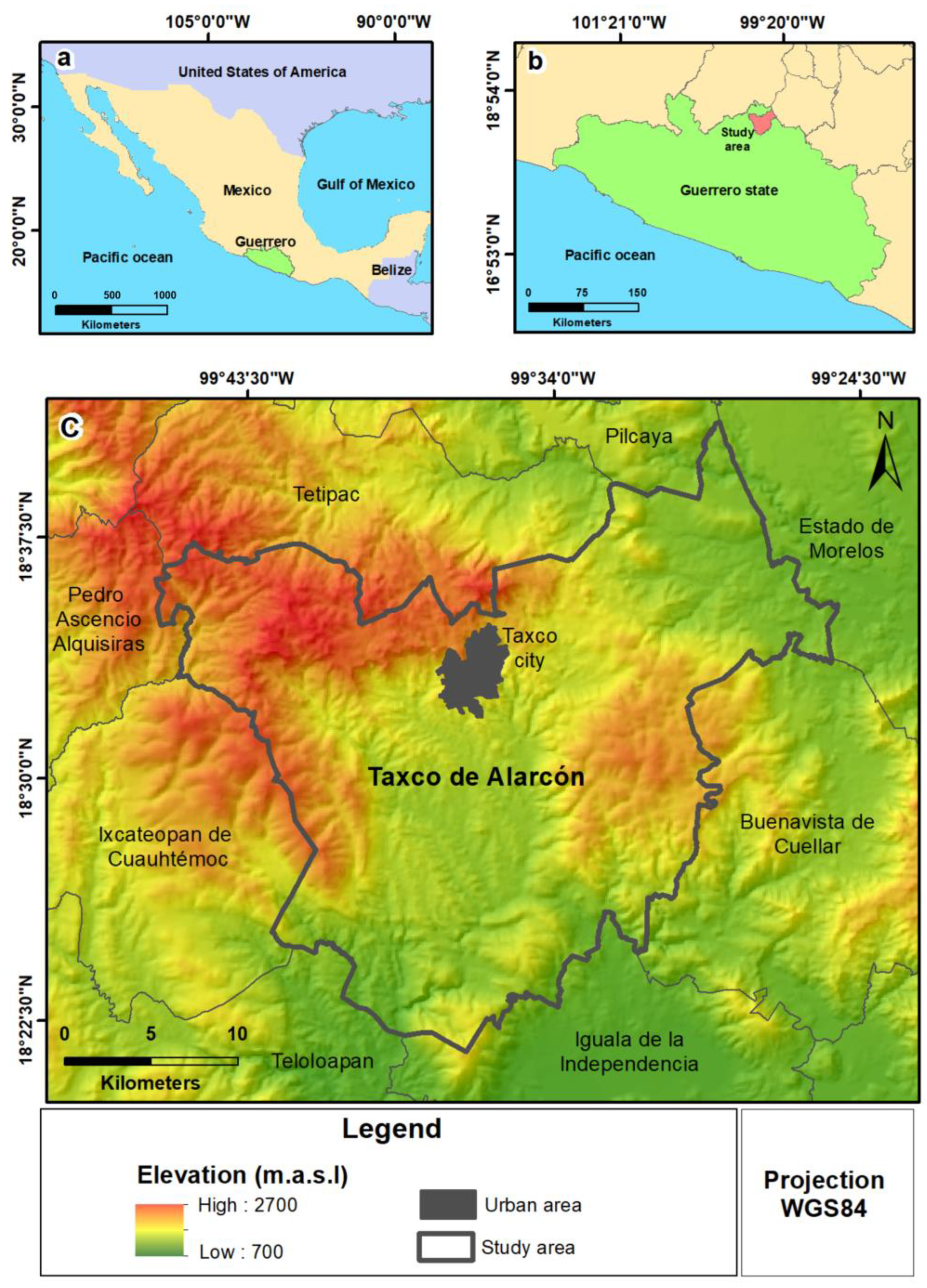
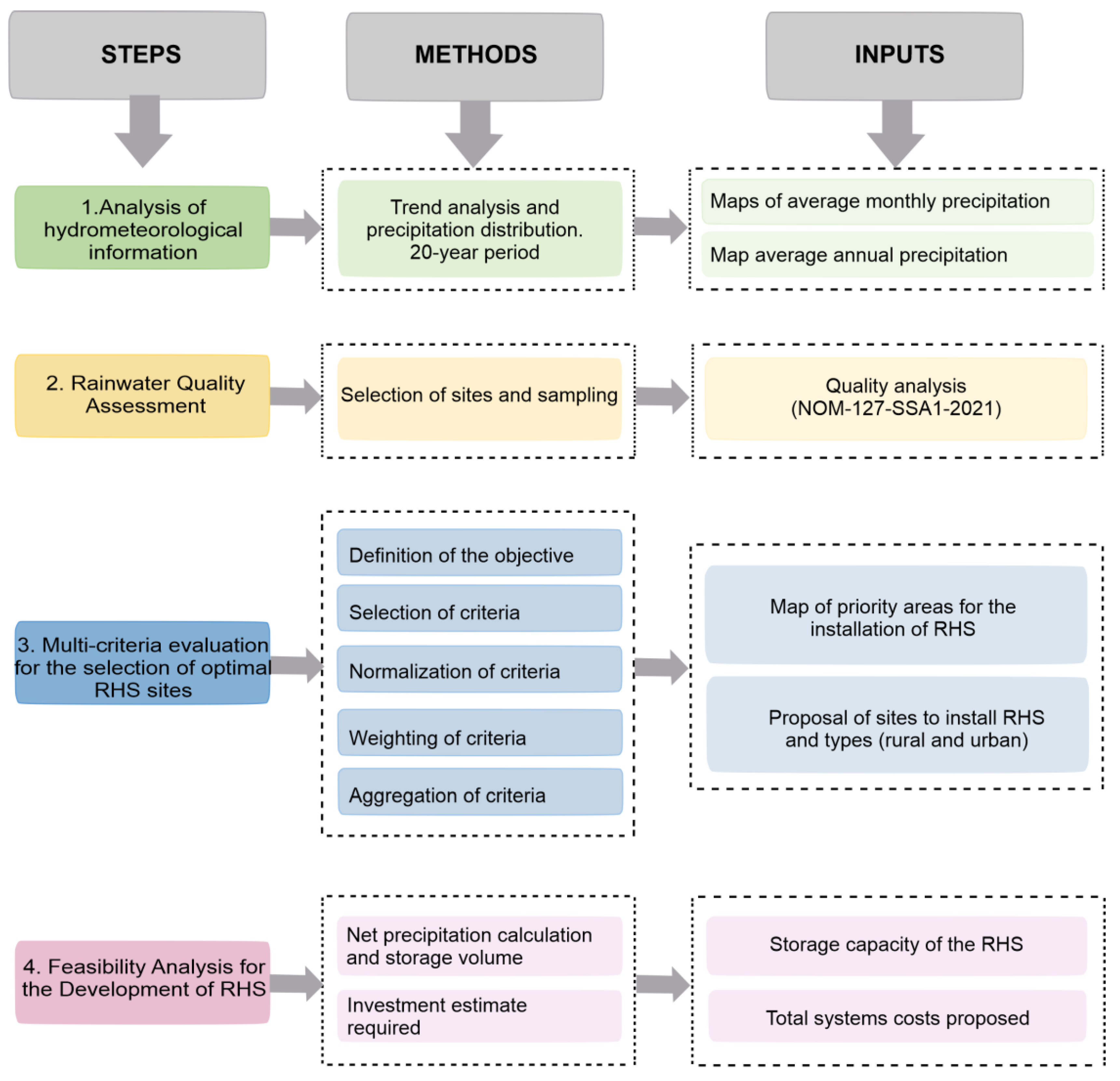
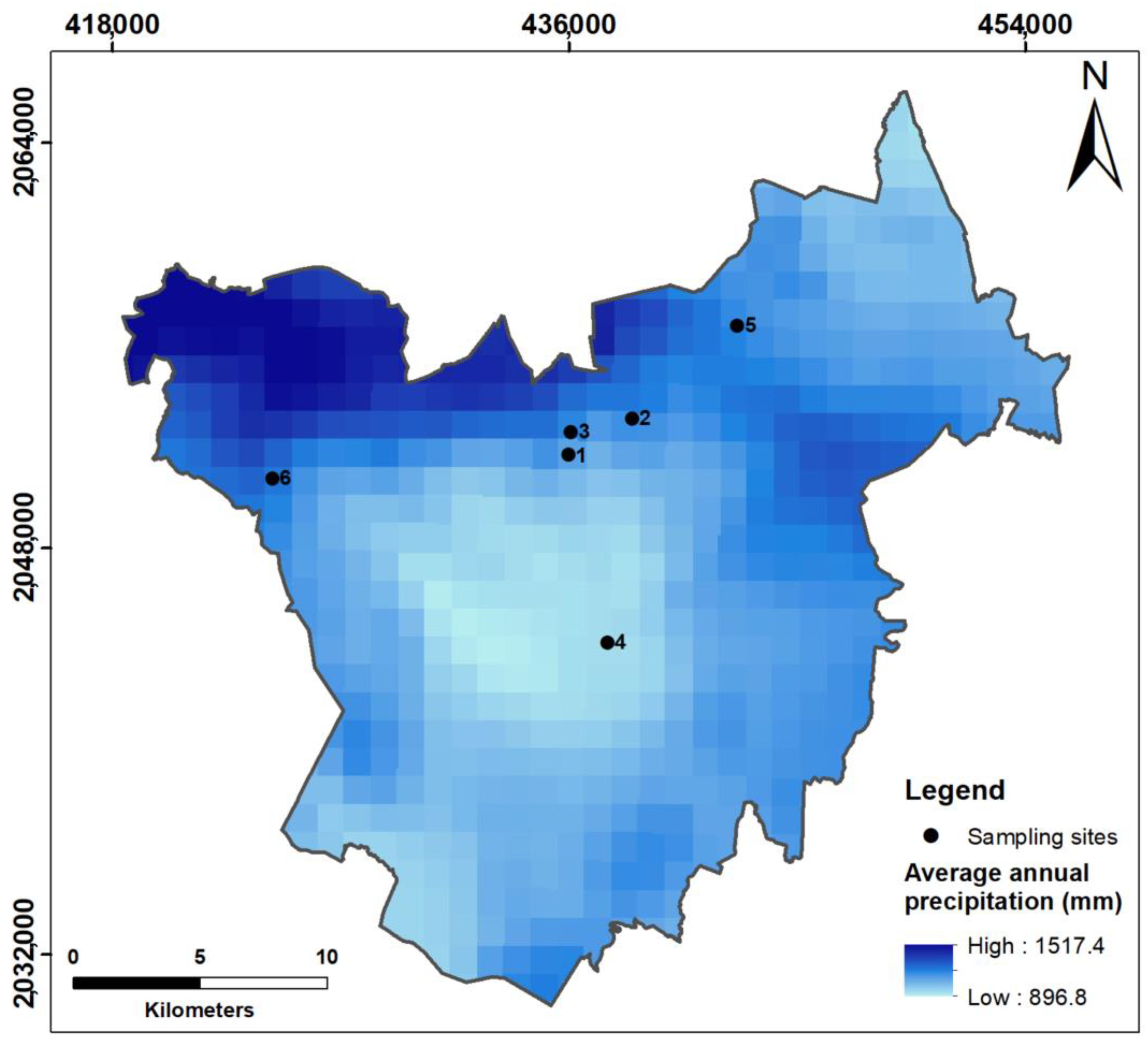
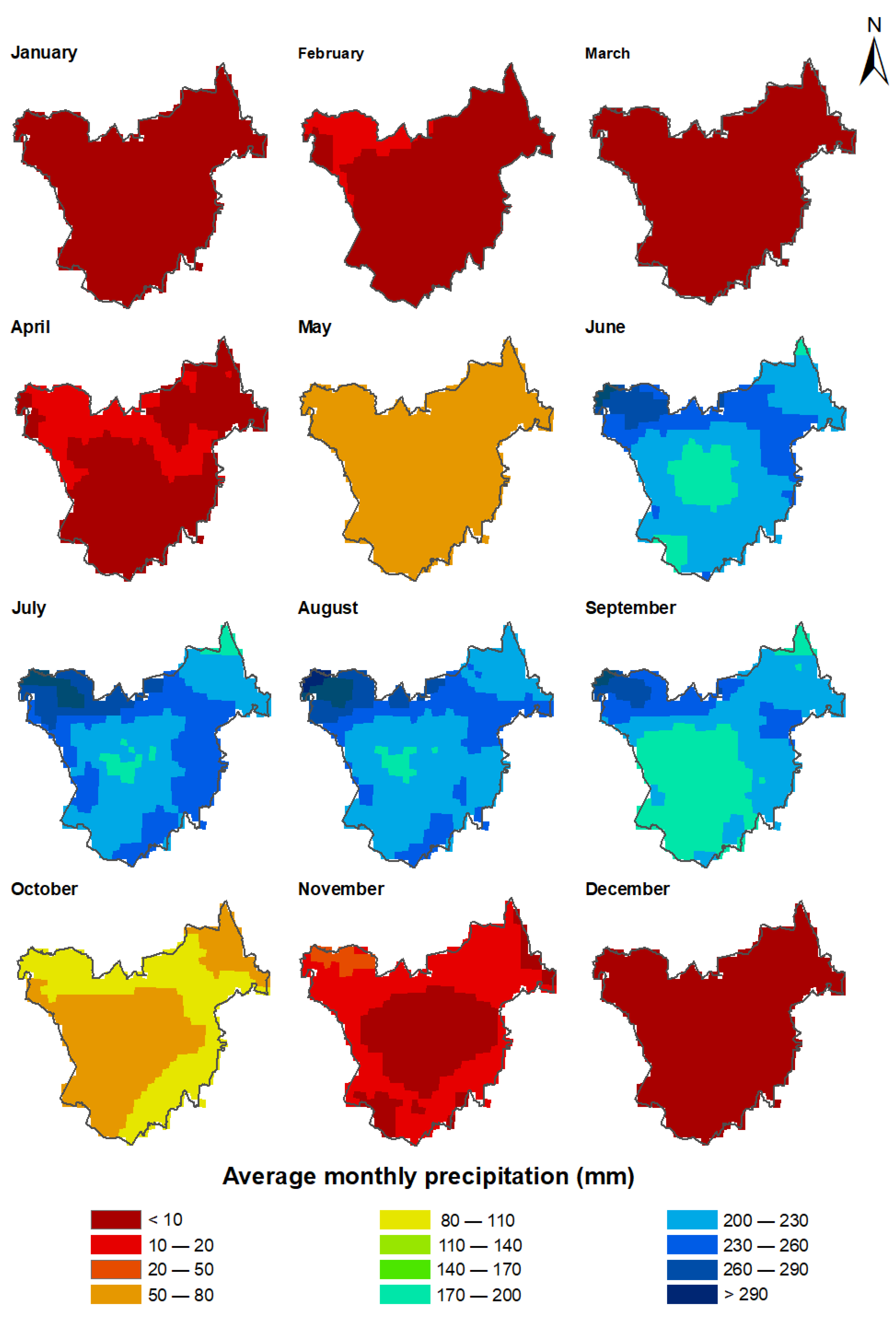
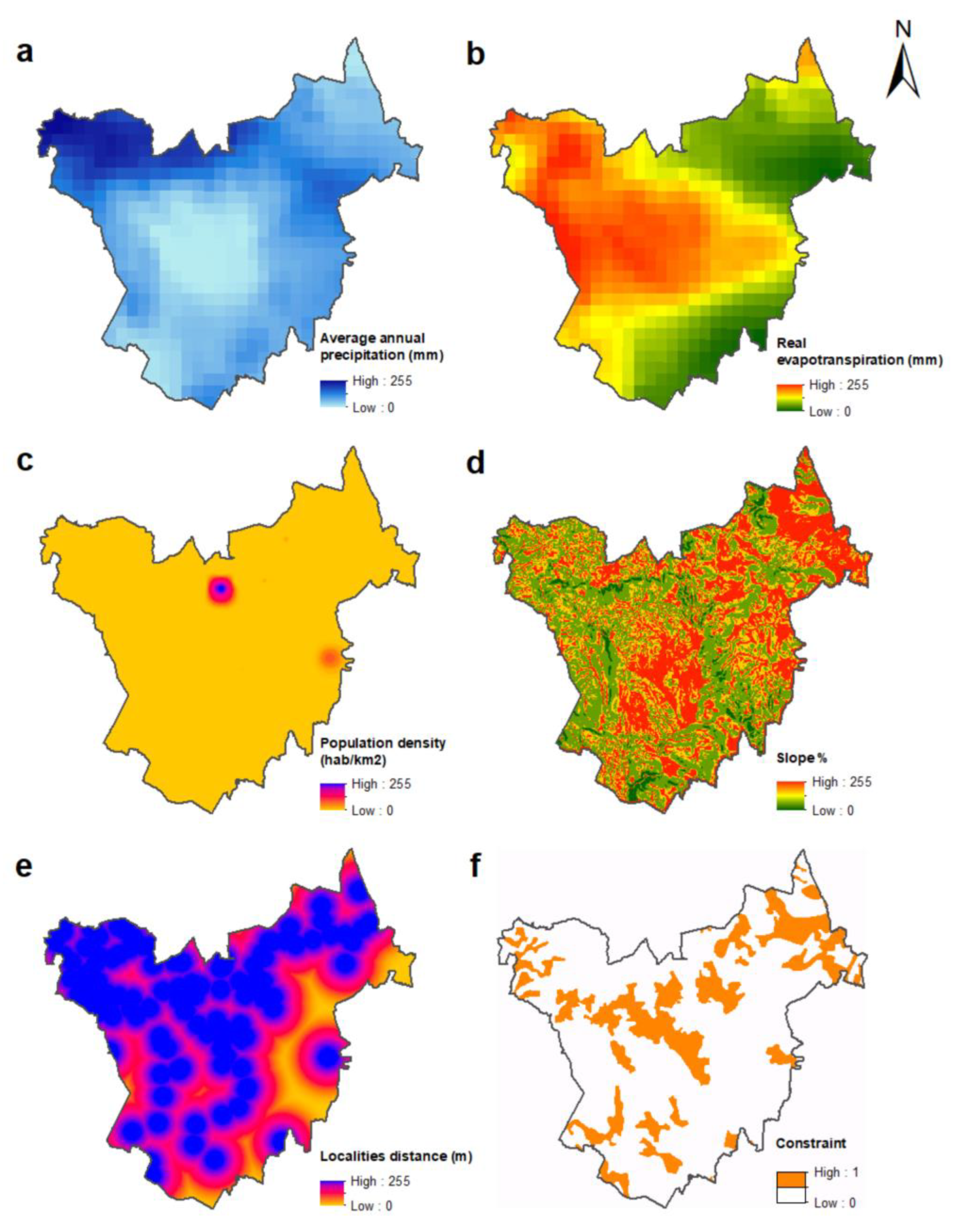
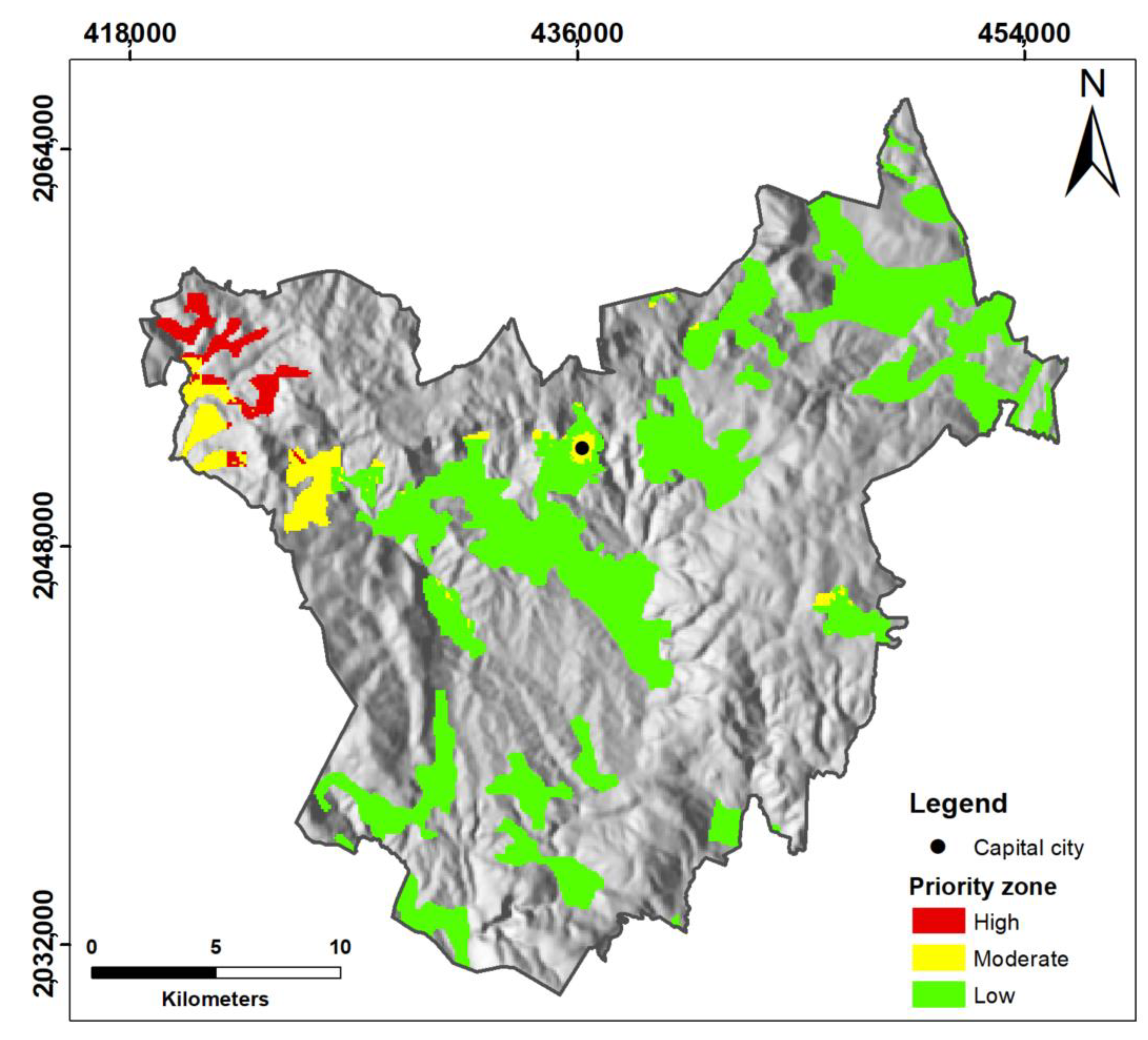
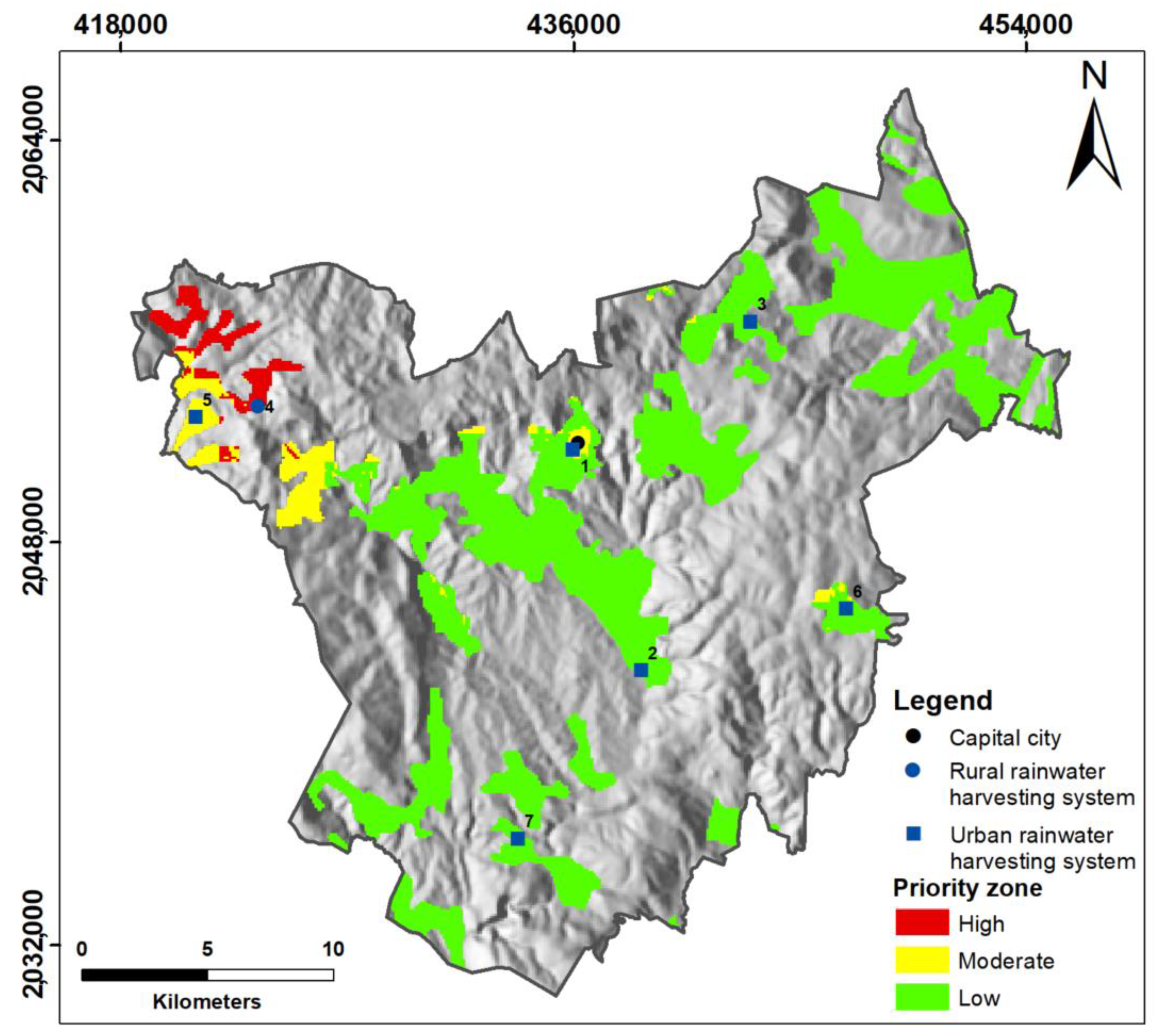
| Rainwater Sampling Stations | |||||
|---|---|---|---|---|---|
| Station id | Locality | x | y | z (m.a.s.l) | Installation date |
| 1 | Pilita | 435,991.3 | 2,051,682.8 | 1761 | 2 June 2022 |
| 2 | Casallas | 438,504 | 2,053,110.8 | 1670 | 3 June 2022 |
| 3 | Agua Blanca | 436,093.7 | 2,052,571.3 | 1869 | 2 June 2022 |
| 4 | Taxco el Viejo | 437,541.1 | 2,044,278.3 | 1461 | 3 June 2022 |
| 5 | Acuitlapán | 442,667.2 | 2,056,779.4 | 1532 | 3 June 2022 |
| 6 | Horconcito | 424,323.5 | 2,050,737.1 | 2376 | 3 June 2022 |
| Factors | Source |
|---|---|
| Precipitation: period 2001 to 2021 | Determined using monthly precipitation data obtained from Daymet [44]. |
| Slope | Determined with the digital elevation model obtained from the United States Geological Survey [45]. |
| Distance to localities | Determined using vector information obtained from the INEGI site [46]. |
| Population density | Determined from vector information obtained from the INEGI site [46]. |
| Real evapotranspiration: period 2001 to 2021 | Determined based on monthly precipitation data and maximum and minimum temperatures obtained from Daymet [44]. |
| Constraint | Source |
| Land use and vegetation | Obtained from INEGI site [46]. |
| Correlation Matrix | Real Evapotranspiration | Population Density | Distance to Localities | Slope | Precipitation |
|---|---|---|---|---|---|
| Real evapotranspiration | 1 | −0.18 | 0.37 | −0.19 | 0.01 |
| Population density | −0.18 | 1 | −0.66 | 0.88 | −0.09 |
| Distance to localities | 0.37 | −0.66 | 1 | −0.58 | −0.08 |
| Slope | −0.19 | 0.88 | −0.58 | 1 | −0.05 |
| Precipitation | 0.01 | −0.09 | −0.08 | −0.05 | 1 |
| Factor | Population Density | Distance to Localities | Real Evapotranspiration | Slope | Precipitation | Weights |
|---|---|---|---|---|---|---|
| Population density | 1 | 0.1149 | ||||
| Distance to localities | 1/5 | 1 | 0.0321 | |||
| Real evapotranspiration | 3 | 7 | 1 | 0.2655 | ||
| Slope | 1/3 | 3 | 1/7 | 1 | 0.0574 | |
| Precipitation | 7 | 9 | 3 | 7 | 1 | 0.5300 |
| Sites Proposed for RHS Installation | ||||
|---|---|---|---|---|
| Id | Locality | x | y | z (m.a.s.l) |
| 1 | Pilita | 435,991.3 | 2,051,682.8 | 1761 |
| 2 | Taxco el Viejo | 438,705.1 | 2,042,909.7 | 1221 |
| 3 | Acuitlapán | 443,050.8 | 2,056,778.7 | 1573 |
| 4 | Horconcito | 423,441.8 | 2,053,396.7 | 2376 |
| 5 | Santo Domingo | 420,971.5 | 2,052,984.8 | 2093 |
| 6 | Tlamacazapa | 446,861.1 | 2,045,361.4 | 1986 |
| 7 | Huahuaxtla | 433,789.9 | 2,036,210.9 | 1254 |
| RHS | Population | Net Precipitation (mm) | Annual Water Demand (m3) | Catchment Area (m2) | Storage Capacity | |
|---|---|---|---|---|---|---|
| Annual (m3) | Rainy Season (June–October) (m3) | |||||
| Rural | 308 | 1234 | 5621 | 3000 | 180 | 60 |
| Urban | 5 | 731.34 | 182.5 | 180 | 40 | 10 |
| Rural RHS | Urban RHS | |||
|---|---|---|---|---|
| Costs | Annual Supply System | Rainy Season Supply System | Annual Supply System | Rainy Season Supply System |
| Captured volume (m3/year) | 2469 m3 | 2234 m3 | 131.5 m3 | 119 m3 |
| Storage volume (m3/year) | 180 m3 | 60 m3 | 40 m3 | 10 m3 |
| Cost of gutters and downspouts (USD) | not applicable | not applicable | USD 206.6 | USD 206.6 |
| Total Cost (USD) | USD 11,945 | USD 10,576 | USD 2146.6 | USD 1176.6 |
| Cost (UDD/m3) | USD 4.8 | USD 4.7 | USD 16.3 | USD 9.8 |
| Cost annual without storage (USD/m3) | not applicable | not applicable | USD 1.6 | USD 1.7 |
Disclaimer/Publisher’s Note: The statements, opinions and data contained in all publications are solely those of the individual author(s) and contributor(s) and not of MDPI and/or the editor(s). MDPI and/or the editor(s) disclaim responsibility for any injury to people or property resulting from any ideas, methods, instructions or products referred to in the content. |
© 2023 by the authors. Licensee MDPI, Basel, Switzerland. This article is an open access article distributed under the terms and conditions of the Creative Commons Attribution (CC BY) license (https://creativecommons.org/licenses/by/4.0/).
Share and Cite
Rivera Vázquez, B.I.; Salcedo Sánchez, E.R.; Esquivel Martínez, J.M.; Gómez Albores, M.Á.; Gómez Noguez, F.; Gutiérrez Flores, C.; Talavera Mendoza, O. Use of Analytic Hierarchy Process Method to Identify Potential Rainwater Harvesting Sites: Design and Financial Strategies in Taxco de Alarcón, Southern Mexico. Sustainability 2023, 15, 8220. https://doi.org/10.3390/su15108220
Rivera Vázquez BI, Salcedo Sánchez ER, Esquivel Martínez JM, Gómez Albores MÁ, Gómez Noguez F, Gutiérrez Flores C, Talavera Mendoza O. Use of Analytic Hierarchy Process Method to Identify Potential Rainwater Harvesting Sites: Design and Financial Strategies in Taxco de Alarcón, Southern Mexico. Sustainability. 2023; 15(10):8220. https://doi.org/10.3390/su15108220
Chicago/Turabian StyleRivera Vázquez, Blanca Itzany, Edith Rosalba Salcedo Sánchez, Juan Manuel Esquivel Martínez, Miguel Ángel Gómez Albores, Felipe Gómez Noguez, Carina Gutiérrez Flores, and Oscar Talavera Mendoza. 2023. "Use of Analytic Hierarchy Process Method to Identify Potential Rainwater Harvesting Sites: Design and Financial Strategies in Taxco de Alarcón, Southern Mexico" Sustainability 15, no. 10: 8220. https://doi.org/10.3390/su15108220
APA StyleRivera Vázquez, B. I., Salcedo Sánchez, E. R., Esquivel Martínez, J. M., Gómez Albores, M. Á., Gómez Noguez, F., Gutiérrez Flores, C., & Talavera Mendoza, O. (2023). Use of Analytic Hierarchy Process Method to Identify Potential Rainwater Harvesting Sites: Design and Financial Strategies in Taxco de Alarcón, Southern Mexico. Sustainability, 15(10), 8220. https://doi.org/10.3390/su15108220







